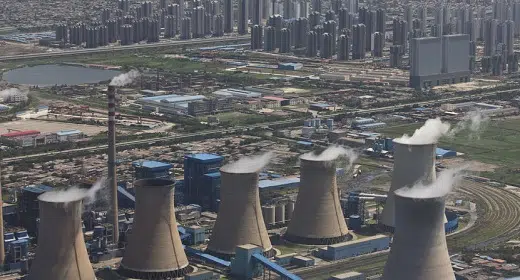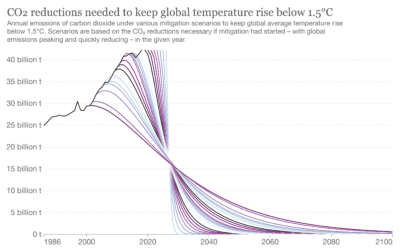by Vaclav Smil: Despite decades of studies and climate summits, greenhouse gas emissions continue to soar…
Energy scientist Vaclav Smil says it’s time to stop ricocheting between apocalyptic forecasts and rosy models of rapid CO2 cuts and focus on the difficult task of remaking our energy system.
he UN’s first climate conference took place in 1992 in Rio de Janeiro, and in the intervening decades we have had a series of global meetings and countless assessments and studies. Annual climate change conferences began in 1995 (in Berlin) and included much publicized gatherings in Kyoto (1997, with its completely ineffective agreement), Marrakech (2001), Bali (2007), Cancun (2010), Lima (2014), and Paris (2015).
In Paris, about 50,000 people flew to the French capital to attend yet another conference at which they were to strike, we were assured, a “landmark” — and also “ambitious” and “unprecedented” — agreement. Yet the Paris Agreement did not codify any specific reduction targets by the world’s largest emitters. And even if all voluntary non-binding pledges were honored (something utterly improbable), the Paris accord would still result in a 50 percent increase of emissions by 2030.
Some landmark.
So what have we done to avert, or to reverse, global warming in the three decades since Rio?
The data are clear: Between 1989 and 2019, we increased global anthropogenic greenhouse gas emissions by about 67 percent. Affluent countries like the United States, Canada, Japan, Australia, and those in the European Union — whose per capita energy use was very high three decades ago — did reduce their emissions, but only by about 4 percent. Meanwhile, Indian greenhouse gas emissions increased 4.3 times, and Chinese emissions rose about 4.8 times. Atmospheric CO2 levels, which for centuries fluctuated narrowly at close to 270 parts per million (ppm), rose in the summer of 2020 to above 420 ppm, more than a 50 percent increase over the late 18th-century level.
Regrettably, we have largely ignored taking steps to limit the long-term impacts of climate change.
Clearly, to conclude that we will be able to achieve decarbonization anytime soon, effectively, and on the required scale runs against all past evidence.
The problem is that rather than take a clear-eyed look at the enormous challenges of phasing out the fossil fuels that are the basis of modern industrial economies, we have ricocheted between catastrophism on one hand and the magical thinking of “techno-optimism” on the other.
In recent decades we have multiplied our reliance on the combustion of fossil fuels, resulting in a dependence that will not be severed easily, or inexpensively. How rapidly we can change this remains unclear. Add to this all other environmental worries, and you must conclude that the key existential question — can humanity realize its aspirations within the safe boundaries of our biosphere? — has no easy answers. But it is imperative that we understand the facts of the matter. Only then can we tackle the problem effectively.
Regrettably, we have largely ignored taking steps that could have limited the long-term impacts of climate change and that should have been taken even in the absence of any global warming concerns because they bring long-term savings and provide more comfort. And as if that were not enough, we have deliberately introduced and promoted the diffusion of new products and energy conversions that have boosted the consumption of fossil energies and hence further intensified CO2 emissions.
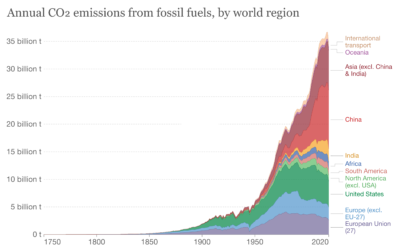
The best examples of these omissions and commissions are the indefensibly inadequate building codes in cold-climate countries, which lead to an exorbitant waste of energy, and the worldwide adoption of SUVs. SUV ownership began to rise in the U.S. during the late 1980s and eventually diffused globally. By 2020 the average SUV emitted annually about 25 percent more CO2 than a standard car. Multiply that by the 250 million SUVs on the road worldwide in 2020, and you will see how the global embrace of these machines has wiped out, many times over, any decarbonization gains resulting from the slowly spreading ownership (just 10 million worldwide in 2020) of electric vehicles.
During the 2010s, SUVs became the second-highest cause of rising CO2 emissions, behind electricity generation. If their mass public embrace continues, they have the potential to offset any carbon savings from the more than 100 million electric vehicles that might be on the road by 2040.
The list of what we have not — but could have — done is long. But to move forward, the first thing we must do is to get real about the primacy of fossil fuels and the challenges ahead.
The increasing dependence on fossil fuels is the most important factor in explaining the advances of modern civilization. An average inhabitant of the Earth now has at his or her disposal 700 times more useful energy than their ancestors had at the beginning of the 19th century. An abundance of this energy underlies and explains the gains — from better eating to mass-scale travel; from mechanization of production and transport to instant personal electronic communication — that have become the norms in affluent countries.
Those who chart their preferred paths to a zero-carbon future owe us realistic explanations, not just assumptions.
For those who ignore the energetic and material imperatives of our world, those who prefer mantras of green solutions to understanding how we have come to this point, the prescription is easy: just decarbonize — switch from burning fossil carbon to converting inexhaustible flows of renewable energies. But we are a fossil-fueled civilization whose technical and scientific advances, quality of life, and prosperity rest on the combustion of huge quantities of fossil carbon, and we cannot simply walk away from this critical determinant of our fortunes in a few decades, never mind years.
Complete decarbonization of the global economy by 2050 is now conceivable only at the cost of unthinkable global economic retreat, or as a result of extraordinarily rapid transformations relying on near-miraculous technical advances. To give just a single key comparison, in 2020 the average annual per capita energy supply of about 40 percent of the world’s population (3.1 billion people, which includes nearly all people in sub- Saharan Africa) was no higher than the rate achieved in both Germany and France in 1860. In order to approach the threshold of a dignified standard of living, those 3.1 billion people will need at least to double — but preferably triple — their per-capita energy use, and in doing so multiply their electricity supply, boost their food production, and build essential infrastructures. Inevitably, these demands will subject the biosphere to further degradation.
What can we do during the coming decades? We must start with the recognition of fundamental realities. We used to consider a 2-degree C (3.6 F) increase in average global temperature as a relatively tolerable maximum. In 2018, however, the Intergovernmental Panel on Climate Change (IPCC) lowered that to 1. 5 C.

Air conditioners in Jeddah, Saudi Arabia. ERIC LAFFORGUE / ART IN ALL OF US / CORBIS VIA GETTY IMAGES
But the latest analysis of combined warming effects concluded that we are already committed to global warming of 2.3 C. It seems highly likely that any chance of holding warming to 1.5 degrees is already gone. Even so, many institutions, organizations, and governments are still theorizing about keeping it at that level.
The IPCC report on 1.5 degrees C of warming offers a scenario based on such a sudden and persistent reversal of our reliance on fossil fuels that emissions of CO2 would be halved by 2030 and eliminated by 2050. Computers make it easy to construct scenarios of carbon elimination, but those who chart their preferred paths to a zero-carbon future owe us realistic explanations, not just sets of more or less arbitrary and highly improbable assumptions detached from technical and economic realities and ignoring the embedded nature, massive scale, and enormous complexity of our energy and material systems.
One rosy scenario, prepared mostly by European Union researchers and unencumbered by real-world considerations, assumes that average global per capita energy demand in 2050 will be 52 percent lower than it was in 2020. Such a drop would make it easy to keep the global temperature rise below 1.5.C. But cutting per capita energy demand by half in three decades would be an astonishing accomplishment given the fact that over the previous 30 years, global per capita energy demand rose by 20 percent.
What miraculous options will be available to African nations reliant on fossil fuels to supply 90 percent of their energy?
The proponents of this unrealistic scenario allow merely a factor-of-two increase across all modes of mobility during the next three decades in what they call the Global South, and a factor-of-three increase in the ownership of consumer goods. But in the China of the past generation, growth has been on an entirely different scale: In 1999 the country had just 0.34 cars per 100 urban households; in 2019 the number surpassed 40 — a more than hundredfold relative increase in only two decades. In 1990, one out of every 300 urban households in China had an air conditioning window unit; by 2018 there were 142.2 units per 100 households — a more than 400-fold rise in less than three decades.
In a second scenario outlining a goal of complete decarbonization by 2050, a group of energy researchers at Princeton University has charted the required shifts in the U.S. The Princeton scenario builders recognize that it will be impossible to eliminate all fossil fuel consumption and that the only way to achieve net- zero emissions is to resort to what they label the “fourth pillar” of their overall strategy — to mass-scale carbon capture and storage of emitted CO2. Their calculation requires the removal of 0.9 billion to 1.7 billion tons of the gas per year. That would necessitate the creation of an entirely new gas capture-transportation and storage industry that every year would have to handle 1.3 to 2.4 times the volume of current U.S. crude oil production, an industry that took more than 160 years and trillions of dollars to build.
Who could be against solutions that are both cheap and nearly instantly effective, that will create countless well-paying jobs and ensure carefree futures for coming generations? Let us all just sing from these green hymnals, follow all-renewable prescriptions, and a new global nirvana will arrive in just a decade — or, if things get a bit delayed, by 2035.
Alas, a close reading reveals that these magic prescriptions give no explanation for how the four material pillars of modern civilization (cement, steel, plastic, and ammonia) will be produced solely with renewable electricity. Nor do they convincingly explain how flying, shipping, and trucking (to which we owe our modern economic globalization) could become 80 percent carbon-free by 2030; they merely assert that it could be so.
What miraculous options will be available to African nations now relying on fossil fuels to supply 90 percent of their primary energy in order to drive down their dependence to 20 percent within a decade? And how will China and India (both countries are still expanding their coal extraction and coal- fired generation) suddenly become coal-free?
It makes no sense to argue with the details of what are essentially the academic equivalents of science fiction. They start with arbitrarily set goals (zero by 2030 or by 2050) and work backward to plug in assumed actions to fit those achievements, with actual socioeconomic needs and technical imperatives being of little, or no, concern.
We are increasingly subjected to opposing propensities to embrace catastrophism and techno-optimism.
Reality thus presses in from both ends. The sheer scale, cost, and technical inertia of carbon-dependent activities makes it impossible to eliminate all of these uses in just a few decades. We cannot instantly change the course of a complex system just because somebody decides that the global consumption curve will suddenly reverse its centuries-long ascent and go immediately into a sustained and relatively fast decline.
We are increasingly subjected to opposing propensities to embrace catastrophism (those who say there are just years left before the final curtain descends on modern civilization) and techno-optimism (those who predict that the powers of invention will open unlimited horizons beyond the confines of the Earth, turning all terrestrial challenges into inconsequential histories). I have little use for either of these positions. I do not see any already predetermined outcomes, but rather a complicated trajectory contingent on our — far from foreclosed— choices.
Catastrophists have always had a hard time imagining that human ingenuity can meet future food, energy, and material needs — but during the past three generations we have done so despite a tripling of the global population since 1950. And techno-optimists, who promise endless, near-miraculous solutions, must reckon with a similarly poor record. One of the best-known failures has been the belief in the all-encompassing power of nuclear fission as the solution to our energy needs.
In the latest burst of intensified catastrophism, some journalists and activists write about climate apocalypse now, issuing final warnings: In the future, areas best suited for human habitation will shrink, large areas of the Earth are to become uninhabitable soon, climate migration will reshape America and the world, average global income will decline substantially. Some prophecies claim that we might only have about a decade left to avert a global catastrophe.
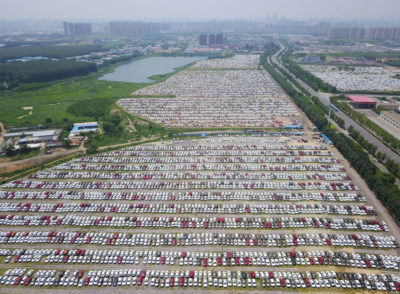
New cars outside the Brilliance factory in Shenyang, China. STR / AFP VIA GETTY IMAGES
I am convinced that we could do without this continuing flood of never-less-than-worrisome and too-often-quite-frightening predictions. How helpful is it to be told every day that the world is coming to an end in 2050 or even 2030? And if these claims are true, why should we even worry about global warming?
On the other side, why is it that some scientists keep on charting such arbitrarily bending and plunging curves leading to near-instant decarbonization? And why are others promising the early arrival of technical super-fixes that will support high standards of living for all humanity? There are no limits to assembling such models, leaving prognosticators to posit 100 percent inexpensive thermonuclear electricity or cold fusion by 2050. Only the imagination limits these assumptions: they range from fairly plausible to patently delusionary.
Such predictably repetitive prophecies (however well-meant and however passionately presented) do not offer any practical advice about the deployment of the best possible technical solutions, about the most effective ways of legally binding global cooperation, or about tackling the difficult challenge of convincing populations of the need for significant expenditures whose benefits will not be seen for decades to come.
The fact is that we can make a great deal of difference, but not by pretending to follow unrealistic and arbitrary goals. History does not unfold as a computerized academic exercise with major achievements falling on years ending with zero or five; it is full of discontinuities, reversals, and unpredictable departures.
We cannot know to what extent we will succeed by 2050, and thinking about 2100 is truly beyond our ken.
We can proceed fairly quickly with the displacement of coal- fired electricity by natural gas (when produced and transported without significant methane leakage, it has a substantially lower carbon intensity than coal) and by expanding solar and wind electricity generation. We can move away from SUVs and accelerate mass-scale deployment of electric cars. And we still have large inefficiencies in construction, household, and commercial energy use that can be profitably reduced or eliminated.
Decarbonization of electricity generation can make the fastest progress, because installation costs per unit of solar or wind capacity can now compete with the least expensive fossil-fueled choices. And some countries have already transformed their generation to a considerable degree.
Major reductions in carbon emissions — resulting from the combination of continued efficiency gains, better system designs, and moderated consumption — are possible, and a determined pursuit of these goals would limit the eventual rate of global warming. But we cannot know to what extent we will succeed by 2050, and thinking about 2100 is truly beyond our ken. For example, was there a single climate modeler who predicted in 1980 the most important anthropogenic factor driving global warming over the last 30 years: the economic rise of China?
What remains in doubt is our collective — in this case global — resolve to deal effectively with at least some critical challenges. Affluent countries could reduce their average per-capita energy use by large margins and still retain a comfortable quality of life. Widespread diffusion of simple technical fixes, ranging from mandated triple windows to designs of more durable vehicles, would have significant cumulative effects.
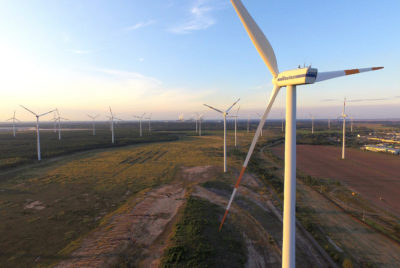
Wind turbines on land that was formerly an open-pit coal mine in Brandenburg, Germany. SEAN GALLUP / GETTY IMAGES
The reality is that any sufficiently effective steps will be decidedly non-magical, gradual, and costly. We have been transforming the environment on increasing scales and with rising intensity for millennia, and we have derived many benefits from these changes — but, inevitably, the biosphere has suffered. There are ways to reduce those impacts, but the resolve to deploy them at required scales has been lacking, and if we start acting in a sufficiently effective manner on a global scale, we will have to pay a considerable economic and social price. Will we act deliberately, with foresight, or will we act only when forced by deteriorating conditions?
New departures, new solutions, and new achievements are always with us. We are a very inquisitive species with a remarkable long-term record of adaptation and with even more remarkable recent accomplishments in making the lives of most of the world’s population healthier, richer, safer, and longer. Still, fundamental constraints persist: We have changed some of them through our ingenuity, but such adjustments have their own limits.
And in a civilization where production of essential commodities now serves nearly 8 billion people, any departure from established practices also runs into the constraints of scale. Even though the supply of new renewables (wind, solar, new biofuels) rose impressively — about fiftyfold during the first 20 years of the 21st century — the world’s dependence on fossil carbon declined only marginally, from 87 percent to 85 percent of the total supply.
Moreover, any effective commitments will be expensive and will have to last for at least two generations in order to bring the desired outcome (of much reduced, if not totally eliminated, greenhouse gas emissions). And even drastic reductions going well beyond anything that could be realistically envisaged will not show any convincing benefits for decades. This raises the extraordinarily difficult problem of intergenerational justice — that is, our never- failing propensity to discount the future.
I am neither a pessimist nor an optimist. I am a scientist trying to explain how the world really works.
We value now more than later, and we price it accordingly. Should average global life expectancy (about 72 years in 2020) remain the same, the generation born near the middle of the 21st century would be the first to experience a cumulative economic net benefit from climate-change mitigation policies. Are the young citizens of affluent countries ready to put these distant benefits ahead of their more immediate gains? Are they willing to sustain this course for more than half a century?
Nobody in 1945 could have predicted a world with more than 5 billion additional people that is also better fed than at any time in history. A lifetime later, there is no reason to believe that we are in a better position to foresee the extent of coming technical innovations, the events that will shape the fortunes of nations, and the decisions (or their regrettable absence) that will determine the fate of our civilization during the next 75 years.
I am neither a pessimist nor an optimist. I am a scientist trying to explain how the world really works. A realistic grasp of our past, present, and uncertain future is the best foundation for approaching the unknowable expanse of time before us. While we cannot be specific, we know that the most likely prospect is a mixture of progress and setbacks, of seemingly insurmountable difficulties and near-miraculous advances. The future, as ever, is not predetermined. Its outcome depends on our actions.







